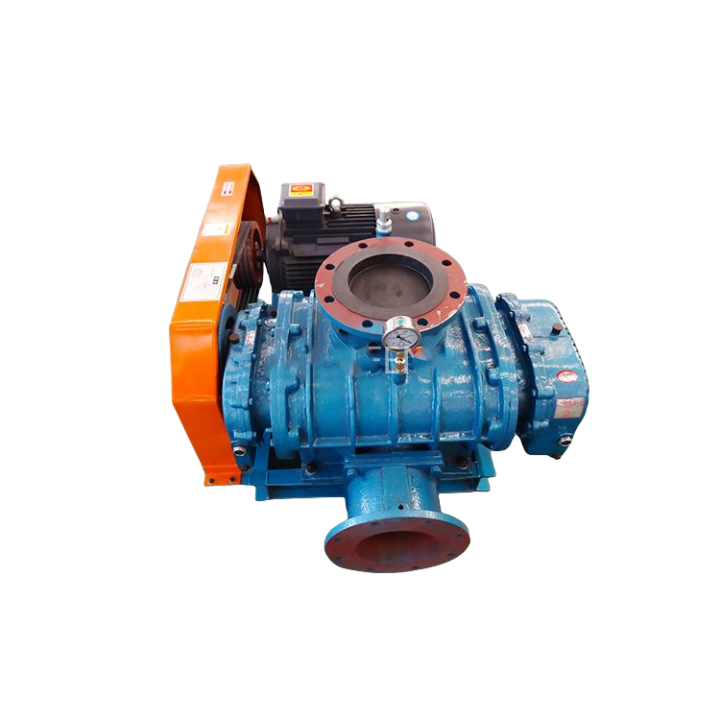The Working Principle of Multistage Roots Vacuum Pumps
2024-06-26
Multistage Roots vacuum pumps, also known as Roots blowers or rotary lobe pumps, are commonly used in various industrial applications requiring high vacuum levels. They operate on the principle of positive displacement and use intermeshing rotors to move gas through multiple stages, achieving high vacuum efficiencies. Here is a detailed explanation of their working principle:

1. Basic Components and Structure
- Rotors: Two or more intermeshing rotors (lobes) mounted on parallel shafts.
- Casings: The rotors are enclosed in a stator or casing.
- Drive Mechanism: A motor or other power source drives the rotors.
- Inlet and Outlet Ports: Gas enters through the inlet port and exits through the outlet port.
2. Positive Displacement Mechanism
- Gas Entrapment: As the rotors rotate, they create a series of small pockets between the lobes and the casing. Gas enters these pockets through the inlet port.
- Gas Movement: The rotation of the lobes moves the trapped gas along the casing toward the outlet port.
- Gas Discharge: When the gas pockets reach the outlet port, the trapped gas is expelled out of the pump.
3. Multistage Configuration
- Sequential Stages: In a multistage Roots vacuum pump, several stages are connected in series. Each stage consists of a set of rotors and a casing.
- Pressure Reduction: The gas undergoes successive pressure reductions as it moves from one stage to the next. This multistage configuration enables the pump to achieve higher vacuum levels than a single-stage pump.
- Interstage Cooling: Often, there are cooling mechanisms between stages to manage the heat generated by compression and to improve efficiency.
4. Non-Contact Operation
- Clearance: The rotors do not touch each other or the casing, which minimizes wear and allows for high-speed operation.
- Synchronization: Timing gears ensure that the rotors remain synchronized, maintaining precise clearances and preventing contact.
5. Gas Handling and Efficiency
- Continuous Flow: The continuous rotation of the lobes ensures a constant flow of gas through the pump.
- Low Pulsation: The design minimizes pulsations in the gas flow, providing a smoother operation compared to other types of vacuum pumps.
- Backflow Prevention: Non-return valves or check valves may be incorporated to prevent backflow and maintain vacuum levels.
6. Operation in Conjunction with Other Pumps
- Booster Pump: Multistage Roots pumps are often used as booster pumps in combination with other types of vacuum pumps, such as rotary vane or screw pumps. The Roots pump increases the overall vacuum efficiency by handling the intermediate pressure range effectively.
7. Applications
- Chemical and Pharmaceutical Industries: For processes like distillation, drying, and degassing.
- Semiconductor Manufacturing: In processes requiring high vacuum levels, such as chemical vapor deposition (CVD) and sputtering.
- Metallurgy: For vacuum furnaces and coating applications.
- Food Processing: In freeze drying and packaging processes.
Diagram of Working Principle
A simplified diagram can help illustrate the working principle:
1. Inlet Port: Gas enters the pump.
2. Stage 1: The first set of rotors traps and moves the gas.
3. Interstage Cooling: (If applicable) The gas is cooled between stages.
4. Stage 2: The second set of rotors further compresses the gas.
5. Additional Stages: (If applicable) Additional stages continue to compress the gas.
6. Outlet Port: The compressed gas is expelled from the pump.
Summary
The multistage Roots vacuum pump is an efficient and reliable solution for achieving high vacuum levels in various industrial applications. Its working principle revolves around the positive displacement of gas through intermeshing rotors in multiple stages, each stage progressively reducing the pressure. Non-contact operation, synchronization, and the capability to work in conjunction with other vacuum pumps make it a versatile and effective tool in demanding environments.


